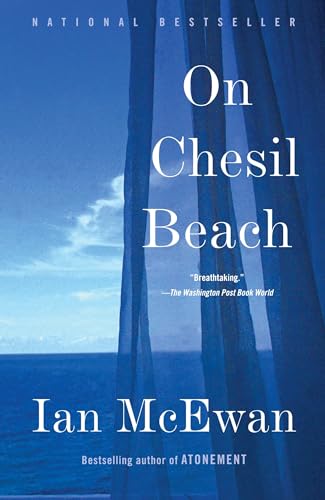Welcome to my review of Ian McEwan’s On Chesil Beach. This novel takes us on a journey through tense and awkward interactions, set against the beautifully ominous backdrop of Chesil Beach. McEwan masterfully portrays societal pressures that shape the lives and relationships of his characters, urging readers to reflect on individuality versus conformity. Let’s explore the emotional intricacies together—and maybe have a laugh or two along the way!
‘On Chesil Beach’ Book Review
In a nutshell
On Chesil Beach is a poignant novella by Ian McEwan, known for his knack in capturing human emotions. It’s a literary fiction piece that dives into the lives of a young couple in 1960s England. The story unfolds on their wedding night, highlighting themes of love, communication, and societal expectations. The novella paints a vivid picture of the era’s societal norms and how they impact the couple’s relationship. Emotions run high as McEwan masterfully crafts a tale of intimacy and misunderstanding, leaving readers wondering about the impact of silence and missed opportunities.
Unraveling Character Development and Interactions in On Chesil Beach
So, I once read Ian McEwan’s masterpiece, “On Chesil Beach,” while chilling on, you guessed it, a non-Chesil beach. I could almost feel the waves whispering the subtle nuances of the characters. This book is like one of those awkward family dinners where nobody knows where to look, but you can’t stop eavesdropping! Florence and Edward, our protagonists, are like an orchestra tuning before the concert. Their interactions and character progression have that pre-show buzz that seems to say, ‘Hey, things are about to get interesting!’
Character development in “On Chesil Beach” is as intricate as my grandma’s quilt. It captures the coming together of two worlds, which is both beautiful and, at times, hilariously jarring. Florence is the classic example of a bottled-up storm, ready to burst with dreams and expectations. Edward, on the other hand, is your typical nice guy, with desires as clear as mud. Their conversations sometimes feel like two ships passing in the night, but then there’s a magic moment where they connect. It’s like trying to figure out a new board game without reading the instructions. Sometimes you nail it, sometimes you’re utterly confused.
Oh, and the secondary characters are like the quirky folks you meet at a book club, each bringing a different flavor to the story. They add depth and spice, without which, Florence and Edward’s world might seem like a one-note tune. The interactions are rich and remind me of a time when I accidentally joined a knitting group thinking it was a comedy workshop. Awkward yet enlightening!
Witnessing how these interactions form the backbone of the story sets the stage for exploring the emotional tension and awkwardness that defines “On Chesil Beach”.
Emotional Tension and Awkwardness in ‘On Chesil Beach’
In Ian McEwan’s masterpiece, ‘On Chesil Beach’, emotional tension and awkwardness take center stage, creating a riveting reading experience. The story follows a newlywed couple, Edward and Florence, on their wedding night. Their relationship is a ticking time bomb of unspoken words and misunderstood gestures, much like when I tried to make a soufflé and ended up with scrambled eggs. Their emotional journey is anything but easy, and quite like my monthly attempts at DIY home projects, it doesn’t exactly go as planned.
The characters are caught in a web of their inner anxieties. Florence, the nervous bride, tries to maintain an air of calmness, similar to how I pretend I understand my partner’s obsession with model trains. Edward, on the other hand, is just trying to get through the night without saying something he might regret. We’ve all been there, right? Like when you accidentally call your boss “Mom” on a Zoom call – pure awkwardness!
This emotional rollercoaster is heightened by their inability to communicate effectively. Florence and Edward stumble through the night as if they’re blindfolded in a maze, each afraid to share their true feelings. Their silence is deafening, echoing the awkward pauses we all experience during first dates, when you’re racking your brain for something to say other than “So, do you like bread?”
In ‘On Chesil Beach’, McEwan expertly crafts scenes dripping with tension and tinged with awkwardness, ensuring readers feel every uncomfortable moment. Stay tuned as we explore how the setting and atmosphere in the book add another layer to this compelling story…
Atmospheric Magic: Setting the Scene in ‘On Chesil Beach’
When I first read On Chesil Beach by Ian McEwan, I was captivated by the setting and atmosphere. The novel paints a vivid picture of an English seaside that feels almost like a character itself. As someone who’s been to a few beaches in my time, I can say McEwan has nailed it—minus the seagulls that steal your lunch!
Chesil Beach is depicted as both beautiful and ominous, much like how my mom described my teenage attitude. The beach stretches 18 miles along the coast, with its pebble landscape lending an air of isolation. This mirrors the emotional journey of the characters. Now, don’t get me wrong, I’m no pebble expert, but McEwan manages to make you feel like each stone has its own story. He sets the mood expertly, blending melancholy with the serenity of the sea, creating an atmosphere that reflects the inner tensions of the couple at the heart of the novel.
The atmosphere is so well crafted that I could almost smell the salt in the air. I began to feel the weight of the fog that seems to hang over the beach, just as it does over the relationship between Edward and Florence. McEwan’s descriptive prowess brings to life the juxtaposition between the vastness of the sea and the intimacy—or lack thereof—between the characters.
As the story unfolds, the contrast between the beautiful setting and the characters’ internal struggles becomes more pronounced, setting the stage for a conversation about societal norms in the next section. Stay tuned as we uncover how societal pressures influence their delicate relationship.
Exploring the Impact of Societal Norms in ‘On Chesil Beach’
“On Chesil Beach” by Ian McEwan throws a hard punch at societal norms. While reading, I couldn’t help but draw parallels with a time my granny warned me about wearing socks with sandals. But the book’s way more serious than my fashion faux pas.
Set in 1962, it features Edward and Florence, a newlywed couple. They’re victims of societal expectations around love, marriage, and intimacy. Back then, these norms dictated many aspects of life. In this tale, they work like invisible handcuffs. As I read, I imagined the characters struggling and tripping over these societal chains—like a bad episode of “Dancing with the Stars.” Awkward moments galore. McEwan captures this tension beautifully, showing us how norms can screw up relationships.
The book screams, “Hey, society! Lighten up!” Edward and Florence’s awkward experiences offer lessons on the dangers of rigid societal norms. Their story highlights that conforming for the sake of appearances doesn’t make anyone happy. I remembered my high school prom date disaster—trying to match my date’s fancy dress code and failing miserably. Just like that, the book shows things can get messy when people feel pressured to fit in.
The narrative offers a timeless insight into the human cost of societal norms, making you think about how they shape behavior. McEwan’s writing nudges readers to question what’s “normal” and embrace individuality over conformity. If nothing else, his storytelling reminds us that breaking free from expectations can lead to real happiness.
Overall, “On Chesil Beach” is a must-read for those who enjoy a good reflection on societal norms. With a mix of humor and emotional depth, I recommend this book. It’s a classic!
Conclusion
So, folks, there you have it. Ian McEwan’s ‘On Chesil Beach’ offers a rollercoaster of emotions wrapped in a beautiful package of awkward interactions and societal norms.
Pros: Strong character development, rich setting, and emotional depth. Cons: May feel slow for action lovers.
Overall, it’s a thought-provoking read that’s worth your time if you love character-driven stories. I recommend giving it a go, just don’t expect a Hollywood-style showdown!


